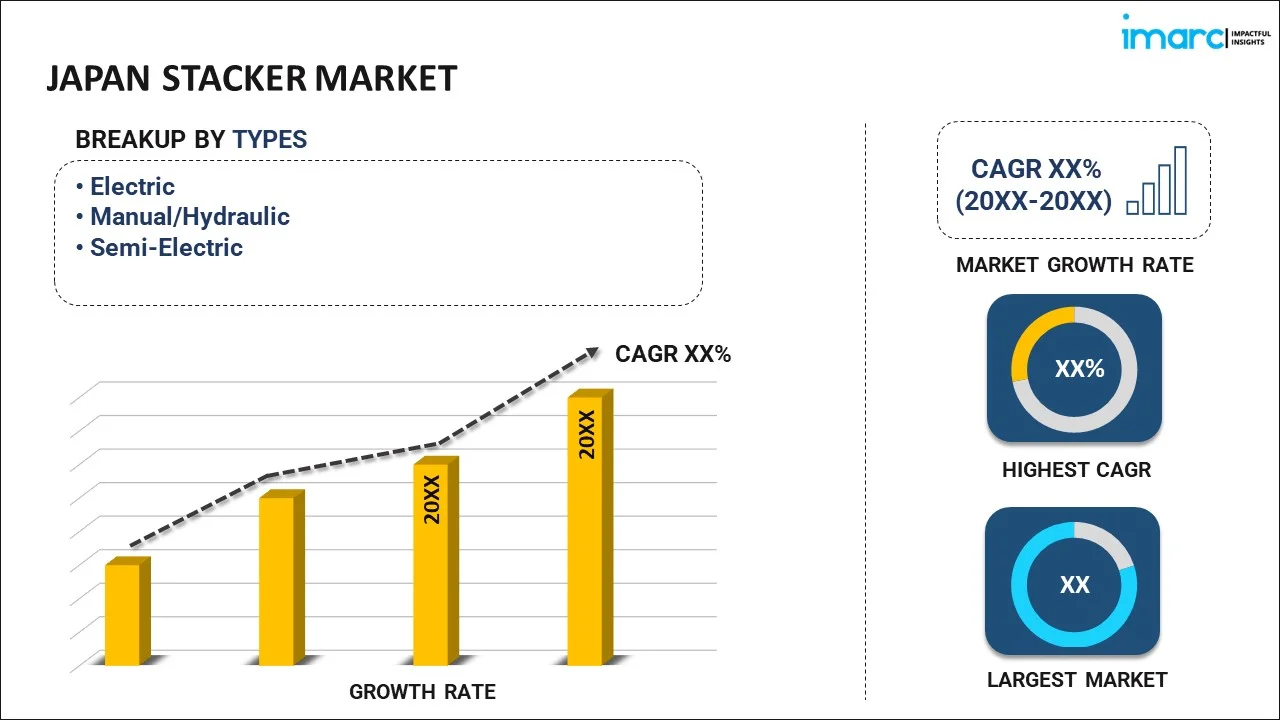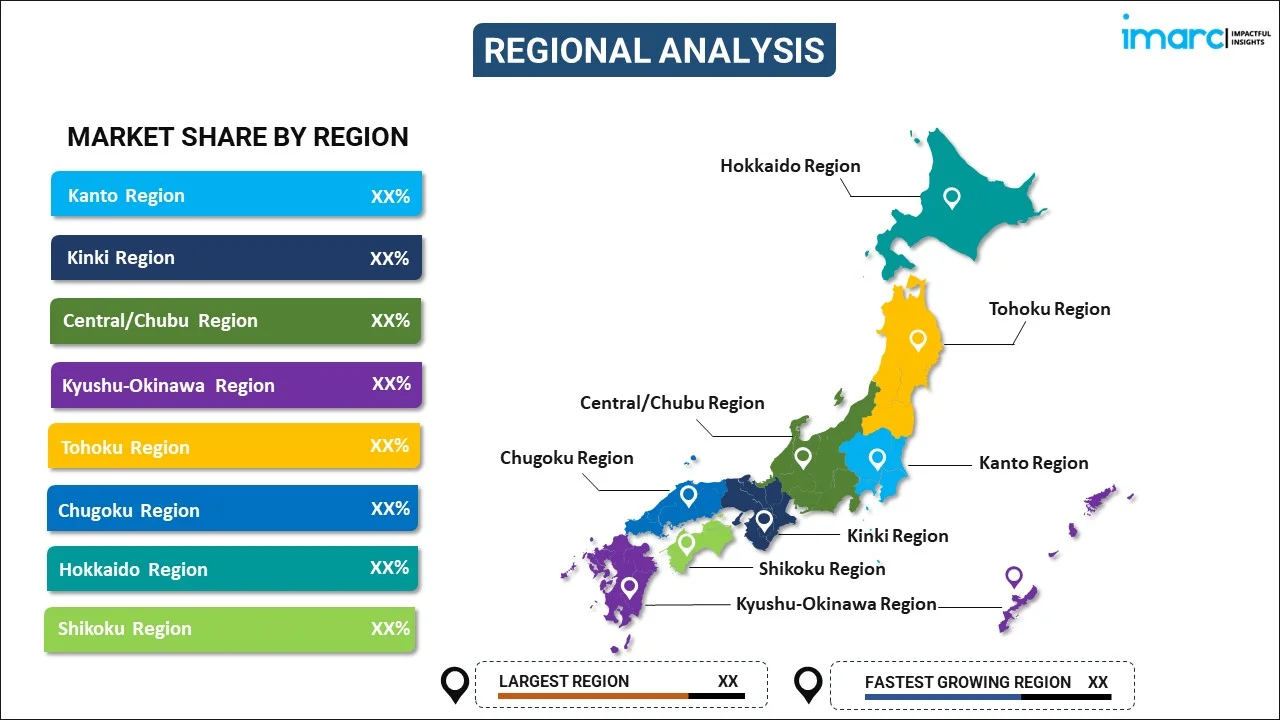
Japan Stacker Market Report by Type (Electric, Manual/Hydraulic, Semi-Electric), End User (Retail and Wholesale, Logistics, Automobile, Food and Beverages, and Others), and Region 2025-2033
Market Overview:
The Japan stacker market size reached USD 137 Million in 2024. Looking forward, IMARC Group expects the market to reach USD 220 Million by 2033, exhibiting a growth rate (CAGR) of 5.4% during 2025-2033. The augmenting product demand in numerous end-use industries requiring efficient material handling solutions, an enhanced emphasis on operational excellence and Lean principles, and the gradual shift towards just-in-time (JIT) manufacturing represent some of the key factors driving the market.
|
Report Attribute
|
Key Statistics
|
|---|---|
|
Base Year
|
2024 |
|
Forecast Years
|
2025-2033
|
|
Historical Years
|
2019-2024
|
| Market Size in 2024 | USD 137 Million |
| Market Forecast in 2033 | USD 220 Million |
| Market Growth Rate (2025-2033) | 5.4% |
A stacker is essentially an industrial lifting appliance that is constructed specifically to elevate, transport, and stack various loads in warehouse, manufacturing, and other industrial settings. This heavy-duty machinery, renowned for its robustness, efficiency, and precision, manifests distinct characteristics. It features a straightforward design with a power-operated fork for lifting palletized goods, which can then be stacked on racks or shelves at considerable heights, well beyond the reach of manual labor. The operating mechanism is intriguing yet straightforward, typically encompassing a hydraulic system for managing the fork's elevation. The user commands the vertical movements, either through manual hydraulic pump operations or electronic switches in more advanced models. The stacker glides on its wheels, ably carrying its payload to the desired location, in a manual or power-propelled fashion, depending on its design. This pivotal apparatus hence amplifies productivity and safety in material handling operations, reducing human strain and injuries, while maximizing space utilization through vertical storage.
Japan Stacker Market Trends:
The market in Japan is primarily driven by the augmenting product demand in numerous end-use industries requiring efficient material handling solutions. This can be attributed to the nation's robust industrial landscape, featuring key sectors such as automobile manufacturing, electronics, and heavy machinery. Moreover, an enhanced emphasis on operational excellence and Lean principles, focused on waste reduction and efficiency improvements is propelling the market. In line with this, the shifting preference for automated and semi-automated stackers in industrial settings for streamlining operations, increasing storage capacity, and enhancing worker safety is creating lucrative opportunities in the market. Additionally, the gradual shift towards just-in-time (JIT) manufacturing in Japan's industrial sector that emphasizes reducing in-process inventory and associated carrying costs, is fueling the demand for fast and efficient logistic solutions. Since e-commerce businesses are reliant on robust warehousing operations, there is an escalating product demand for added help in managing heavy loads, facilitating high stacking, and optimal use of warehouse space. Besides this, the increasing trend towards green technology with a growing predilection for electric and battery-operated stackers over traditional fuel-based variants is creating a positive outlook for the market. This transition, accompanied by the integration of advanced technologies such as IoT and AI for enhanced functionality and predictive maintenance, is impacting the market favorably. Apart from this, the implementation of several government initiatives for industrial safety regulations mandating the use of proper material handling equipment is resulting in a higher product uptake. Some of the other factors contributing to the market include rapid urbanization, growing labor shortage in the country, and growing infrastructure development, especially in transportation and logistics hubs.
Japan Stacker Market Segmentation:
IMARC Group provides an analysis of the key trends in each segment of the Japan stacker market report, along with forecasts at the country level for 2025-2033. Our report has categorized the market based on type and end user.
Type Insights:

- Electric
- Manual/Hydraulic
- Semi-Electric
The report has provided a detailed breakup and analysis of the market based on the type. This includes electric, manual/hydraulic, and semi-electric.
End User Insights:
- Retail and Wholesale
- Logistics
- Automobile
- Food and Beverages
- Others
A detailed breakup and analysis of the market based on the end user has also been provided in the report. This includes retail and wholesale, logistics, automobile, food and beverages, and others.
Regional Insights:

- Kanto Region
- Kinki Region
- Central/ Chubu Region
- Kyushu-Okinawa Region
- Tohoku Region
- Chugoku Region
- Hokkaido Region
- Shikoku Region
The report has also provided a comprehensive analysis of all the major regional markets, which include Kanto Region, Kinki Region, Central/ Chubu Region, Kyushu-Okinawa Region, Tohoku Region, Chugoku Region, Hokkaido Region, and Shikoku Region.
Competitive Landscape:
The report has also provided a comprehensive analysis of the competitive landscape in the market. Competitive analysis such as market structure, key player positioning, top winning strategies, competitive dashboard, and company evaluation quadrant has been covered in the report. Also, detailed profiles of all major companies have been provided.
Japan Stacker Market Report Coverage:
| Report Features | Details |
|---|---|
| Base Year of the Analysis | 2024 |
| Historical Period | 2019-2024 |
| Forecast Period | 2025-2033 |
| Units | Million USD |
| Scope of the Report | Exploration of Historical and Forecast Trends, Industry Catalysts and Challenges, Segment-Wise Historical and Predictive Market Assessment:
|
| Types Covered | Electric, Manual/Hydraulic, Semi-Electric |
| End Users Covered | Retail and Wholesale, Logistics, Automobile, Food and Beverages, Others |
| Regions Covered | Kanto Region, Kinki Region, Central/ Chubu Region, Kyushu-Okinawa Region, Tohoku Region, Chugoku Region, Hokkaido Region, Shikoku Region |
| Customization Scope | 10% Free Customization |
| Post-Sale Analyst Support | 10-12 Weeks |
| Delivery Format | PDF and Excel through Email (We can also provide the editable version of the report in PPT/Word format on special request) |
Key Questions Answered in This Report:
- How has the Japan stacker market performed so far and how will it perform in the coming years?
- What has been the impact of COVID-19 on the Japan stacker market?
- What is the breakup of the Japan stacker market on the basis of type?
- What is the breakup of the Japan stacker market on the basis of end user?
- What are the various stages in the value chain of the Japan stacker market?
- What are the key driving factors and challenges in the Japan stacker market?
- What is the structure of the Japan stacker market and who are the key players?
- What is the degree of competition in the Japan stacker market?
Key Benefits for Stakeholders:
- IMARC’s report offers a comprehensive quantitative analysis of various market segments, historical and current market trends, market forecasts, and dynamics of the Japan stacker market from 2019-2033.
- The research study provides the latest information on the market drivers, challenges, and opportunities in the Japan stacker market.
- Porter's five forces analysis assist stakeholders in assessing the impact of new entrants, competitive rivalry, supplier power, buyer power, and the threat of substitution. It helps stakeholders to analyze the level of competition within the Japan stacker industry and its attractiveness.
- Competitive landscape allows stakeholders to understand their competitive environment and provides an insight into the current positions of key players in the market.
Need more help?
- Speak to our experienced analysts for insights on the current market scenarios.
- Include additional segments and countries to customize the report as per your requirement.
- Gain an unparalleled competitive advantage in your domain by understanding how to utilize the report and positively impacting your operations and revenue.
- For further assistance, please connect with our analysts.
 Inquire Before Buying
Inquire Before Buying
 Speak to an Analyst
Speak to an Analyst
 Request Brochure
Request Brochure
 Request Customization
Request Customization




.webp)




.webp)












